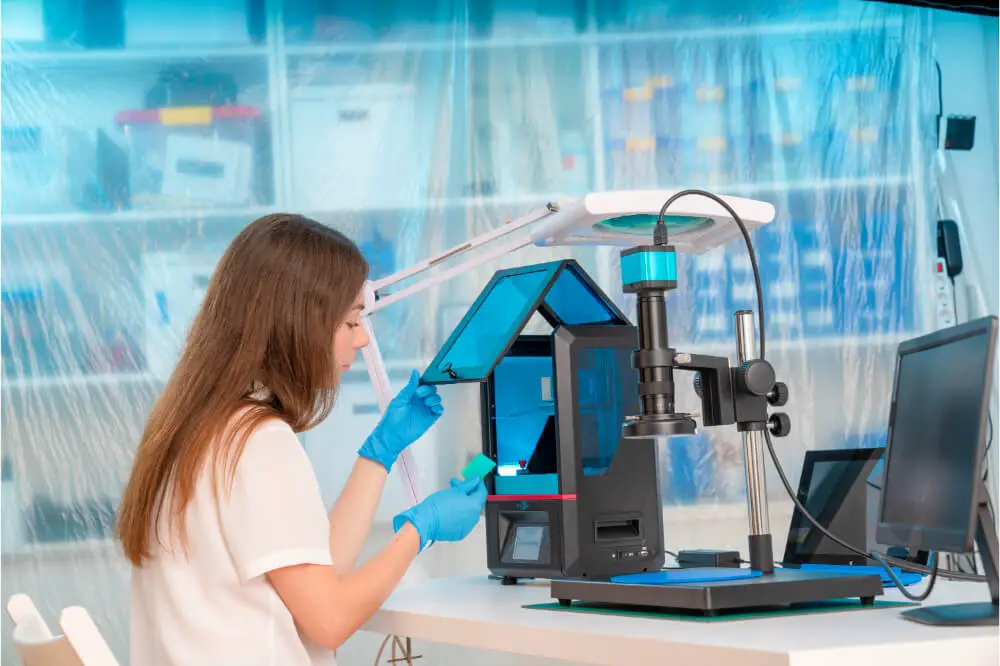Not all 3D printers are the same…
They come with different technology, different printing methods, and use different materials. But what would life be like if there was not some variety to spice it up. Since life is filled with differences it stands to reason that 3D printers will have some variety to them.
The resin 3D printer is just one of a few ways to get your object printed in 3 dimensions. Just because it is different doesn’t mean that it is inferior or bad. It is just a unique way to get your printing tasks done.
To learn more about the 3D resin printers and how they work, just continue to read our article. It has the information you want to know about.
What makes a 3D resin printer a resin printer
This style of modern day printing has some unique qualities to it that distinguish it from other styles of 3D printing. Here are some of those characteristics:
- This style creates 3D objects through photopolymerization
- A code is needed to make these printers do their work
- UV or daylight resins are needed to complete their work
- The material is not a filament nor a powder and needs to be stored in a vat
Keep in mind that the term 3D resin printer is an umbrella term used to describe all similar styles of printing. Also, resin printers is not the official title to describe this method of printing. It is just the easiest way to describe them.

How do 3D resin printers work
Understanding the resin printer means understanding how it does its job and the first item in understanding how they work is knowing the parts of the printer. These parts are:
- Light source
- Build platform
- Mirrors
- Resin tank or vat
There is some flexibility in setting up those components and you can arrange them in such a way that the printer builds the object right side up or upside down. Then the following table explains how they work:
| Task | Description |
|---|---|
| Fill the vat or tank | This can be done automatically or manually. Just make sure not to let the resin touch your body, some resins are toxic |
| Moving the build platform | The printer does this moving it up or down depending on the style of the build and places a thin layer of resin on the platform |
| Light source | Once that resin is laid down the light source draws the pattern of a single layer of the object in the rein and hardens it |
| Build platform | This moves up or down so the machine can build a new layer of resin |
| Roller | Not on every 3D resin printer but its job is to smooth out the resin so it lies perfect |
| Process | Each step above is repeated until the object is built |
There is some post printing work to be done
Unfortunately, even this style of 3D printing is not perfect and the printed object needs some port printing work to make it ready for viewing,handling and so on. Here are some of the post printing work you need to do to get a finished product:
| Task | Explanation |
|---|---|
| Washing | This removes uncured resin from the print and you can do this by using alcohol, water or letting the object dry on paper towels |
| UV Curing | Using this option exposes the object to UV rays to strengthen the object. This is a must step |
| Support removal | Another must step as resin printed objects need supports to form properly. Just be careful when removing them so you do not damage the object |
| Sanding | The smoothing out of the printed object can be done through wet or dry sanding |
| Escape hole patching | For those prints that are hollow. These escape holes need to be covered to make the object look good |
| Finishing | This procedure entails covering imperfections with a coating to make them look better. To do this you can use primer or special coatings |
| Painting | After finishing, you can paint your object to look great |
| Polishing | It’s a little extra work but it helps smooth out your object and get it to shine |
These steps can be done either manually or with special tools designed to handle each step. Machines are available to handle the washing, sanding and curing parts of the post print process.
There is no uniformity with 3D resin printers
That is one reason why all 3D printers, including resin models, are not the same. You cannot interchange, for the most part, the different resins and have one that works for one printer work for another.
The reason for that is because resins vary by monomers, oligomers, and photoinitiators in their blend. This is why SLS resins won’t work in DLP printers. Different ingredients are used to meet the demands of different printing needs.
Those differences are found in the following elements needed for the resins to do their job well:
- Wavelength required for curing
- Exposure time for solidification
- Stiffness and strength
- Highest possible resolution
- Biocompatibility
- Chemical and mechanical Resistance
The many different resins available
There is a large selection of resins you can use so your printing needs can be met with success:
- Standard resin- a n almost universal resin that works in most applications
- Glass reinforced resin- uses glass particles to make the print stronger
- Durable resin- for those objects that receive rough treatment
- Flexible resin- used for bendable objects that need flexibility
- Tough resin- ABS like in nature for those objects that have to be stiff
- Dental resin- for medical objects
- High temperature resin- for those objects facing high extreme temperatures
- Castable resin- makers of molds and jewelers
- Shell casting resin- makes molds for soft parts
- Ceramic resin- to mimic ceramic materials
- Clear resin for a clear glass like look
Some final words
There is more to 3D resin printing than meets the eye. One of those issues will be the cost of the machine and the resin. This style of 3D printing is not for the faint of heart or those lacking in funds.


